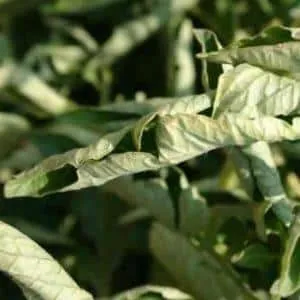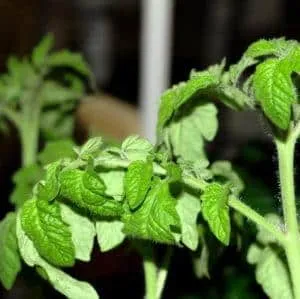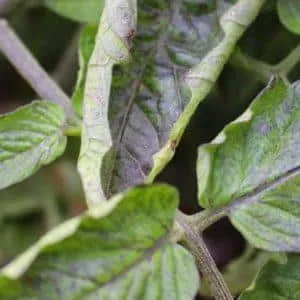Growing tomatoes is not difficult if approached responsibly. However, even experienced gardeners sometimes make mistakes, resulting in a less abundant harvest than expected. To ensure your tomato plants thrive, attention must be paid not only to cultivation but also to combating external factors that may negatively impact yield.
If a plant begins to wilt, it is crucial to identify the cause as quickly as possible. In this article, we will explore in detail what to do when tomato leaves start curling.
Table of contents
Why Do Tomato Leaves Curl?
There are several reasons why tomato leaves may curl, ranging from improper care to environmental factors.
Common causes include:
- Lack of water;
- Overwatering;
- Pest infestation;
- High air temperatures;
- Improper pruning (suckering);
- Nutrient imbalance due to incorrect fertilisation.
There are many reasons why tomato leaves curl, whether grown outdoors or in a greenhouse. Let’s examine each one separately.
Lack of Water
 Experienced gardeners water tomatoes only when the tips of the leaves begin to droop slightly. This is the plant’s way of signalling that it lacks moisture in its stems and leaves.
Experienced gardeners water tomatoes only when the tips of the leaves begin to droop slightly. This is the plant’s way of signalling that it lacks moisture in its stems and leaves.
If this moment is missed and the tomato plant is not watered, the leaves will start to curl. The plant does this to reduce the surface area from which water evaporates. If this happens during flowering, the lack of water may cause flowers to drop.
How to fix the issue: Water the plant in several stages, using 3-5 litres per plant per watering session. Afterwards, ensure regular soil moisture.
Note! Avoid overwatering. Both underwatering and overwatering can harm the crop.
Excessive Watering
Overwatering can also cause leaves to curl. If tomatoes are grown in a greenhouse, the solution is to stop watering temporarily and increase ventilation to reduce humidity.
In open ground, excessive water due to rain can be managed by installing a plastic roof over the bed. This will protect the soil from excess moisture. Loosening the soil also helps it dry faster.
High Temperatures
In hot weather, especially under direct sunlight, tomato leaves curl as a protective mechanism. They uncurl once temperatures drop.
How to help the plants:
- In a greenhouse – increase ventilation;
- In open beds – provide shade using garden fleece or agrotextile (a specialised material).
Nutrient Imbalance Due to Fertilisation
 Gardeners often over-fertilise tomatoes with nitrogen-based fertilisers. If the soil is excessively enriched with manure, the upper leaves may curl into rings. The solution is to stop nitrogen-based fertilisation.
Gardeners often over-fertilise tomatoes with nitrogen-based fertilisers. If the soil is excessively enriched with manure, the upper leaves may curl into rings. The solution is to stop nitrogen-based fertilisation.
However, nutrient deficiency can also occur if plants are not fertilised at all. A lack of micronutrients can cause leaf curling, sometimes accompanied by dry leaf tips.
Common deficiencies include:
- Phosphorus. Leaves curl away from the stem at a sharp angle and may turn purple;
- Potassium. Leaves curl upwards and become crinkled.
To replenish micronutrients, wood ash can be used. Mix 1 litre of ash with 10 litres of water. For better nutrient release, the solution can be boiled. The recommended dosage is 1 litre per plant.
Note! Always apply the ash solution when it has completely cooled.
Ash can also be used dry. Sprinkle 0.3-0.5 cups directly around the base of each plant.
Improper Pruning (Suckering)
 Gardeners often prune tomato plants by removing side shoots (suckers). This is believed to conserve nutrients and improve yield quality.
Gardeners often prune tomato plants by removing side shoots (suckers). This is believed to conserve nutrients and improve yield quality.
However, improper pruning can cause leaves to wilt and curl. This happens when too many suckers are removed at once, especially large ones. The plant undergoes severe stress and may even drop flowers.
To help the plant recover, foliar feeding can be applied. Tomatoes respond well to a boron solution. Dissolve 0.5 teaspoons of boric acid in 10 litres of water and spray generously.
Caution! Boric acid crystals should be dissolved in hot water first, as they do not dissolve well in cold water and may cause leaf burns.
Pest Infestation
Tomatoes can be attacked by pests, causing leaves to yellow or curl upwards.
Common pests include:
- Whitefly. Tiny white-winged insects that fly up when disturbed. Larvae leave a sticky residue on leaves;
- Aphids. These pests suck sap from young leaves;
- Mites. For example, rust mites, which damage leaves and stems, causing curling and rusty-brown cracks.
How to Treat Tomato Leaf Curl
 How can you treat leaf curl caused by pests?
How can you treat leaf curl caused by pests?
Effective natural remedies include:
- Garlic spray. Mix 1 litre of water with 150-200 g of chopped garlic. Let it steep for 5 days. Dilute 1-2 tablespoons of concentrate in 1 litre of water before spraying;
- Wormwood infusion. Steep 500-650 g of wormwood in 5 litres of boiling water for 2-3 days. Dilute 1 litre of concentrate in 9 litres of water before use;
- Tobacco solution. Soak 200 g of shredded tobacco in 5 litres of boiling water for 1-2 days. Spray plants (optional: add 100 g of mild soap).
Note! Repeat treatments every 3-5 days for best results.
Preventive Measures
Prevention is the best defence against pests. Before planting, till the soil thoroughly and treat it with boiling water or a copper sulphate solution (follow package instructions).
Choose tomato varieties resistant to pests and diseases.
Important! Follow crop rotation rules—avoid planting tomatoes in the same spot for 3-4 years.
Conclusion
Tomato leaf curl can result from various factors, including improper watering, nutrient imbalances, or pests. Correctly identifying the cause and taking appropriate action will help ensure a healthy and abundant harvest.







